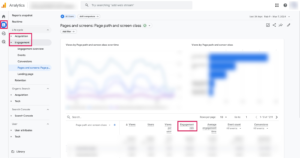With Google’s PageSpeed Insights and other similar, easy-to-use speed scoring tools, website speed has become a seemingly easy metric to deduce and optimize. However, once you look at the audits they provide, you may be wondering where to start. How much can you actually improve on? How far up will optimizing this metric take your site in rankings?
To set you on the right track for speed optimization, we’ll discuss quick improvements, commonly seen failed audit items, and how truly effective speed is to search engine rankings.
Take a Look at Third Party Javascript
A failed audit that is likely to be seen by just about everyone scoring their web speed, especially those using a CRM, is Reduce unused JavaScript. In the list of JavaScript to reduce will be scripts from third parties like HubSpot, HotJar, Facebook, and even Google themselves. All these scripts are usually needed to gather necessary analytical data and user information for your day-to-day marketing activities. So what can be done?
- Audit all the scripts you use to ensure you’re still utilizing their data and that they are completely necessary. Removing any actual unused scripts is the quickest way to shave time off your page load for this particular item.
- Use Google Tag Manager (GTM). GTM is a great way to optimize the page load of third-party scripts by offering ways to organize them and delay loading them until they’re needed.
- Talk to a developer about delaying, deferring, or making asynchronous scripts that you can’t move to GTM.
It might not be possible to completely succeed in this audit, especially when using a CRM that utilizes many different scripts to provide the amount of data to you that it does. The important thing is to ask yourself if a few points on a page score would be worth losing out on that data.
Optimize Your Site’s Different Images
This is the easiest change you can make that affects multiple audit items and often even gives you the largest boost to your website speed. Here are some ways you can optimize your images:
- Use the right file format to produce the best quality at the lowest file size. PNG is best for graphics that include transparency or items with sharp edges, like text. JPEG is your best choice when it comes to photographs or other natural imagery. GIFs should only be used for animations. SVG should be used for vector graphics.
- Compress your PNGs. PNGs are inherently larger than JPEGs, but can have their file size further reduced using tools like TinyPNG that use smart lossy compression. TinyPNG also lets you compress JPEGs, but you need to be careful, as the further you compress a JPEG, the lower the quality becomes.
- Optimize image sizes by determining the smallest size you can use on your site without losing quality. Images should at least be double the size of their largest visual size on mobile (to retain quality on retina displays). If your image is larger than that on a desktop, then the image size should be no larger than its largest size on a desktop.
- Use next-gen formats like WEBP. If you’re using HubSpot or any other CMS that automatically converts images to next-gen formats, but you’re still seeing the Serve images in next-gen formats as an opportunity for savings, you need to reduce the size of your images. PageSpeed Insights doesn’t actually look for the next-gen file formats on your site. It instead takes your images, converts them to next-gen formats, and compares the file sizes. If PageSpeed converted image results in a reduction of file size, it’ll tell you to serve them as next-gen, even if they already are.
- Add exact width and height. You may need a developer’s help on this one. as the width and height should be added to the coded image tag. Adding an explicit width and height to your images reduces layout shifts on your page by telling the page beforehand how much space it’ll need for the image.
Analyze Other Website Metrics Crucial to Speed
Google’s PageSpeed Insights are not an end-all-be-all to the actual performance of your page. It’s simply a tool to help you find areas you can improve.. To get an overall look at how your page performs in load time, you should include other data points in your analysis.
- User Testing is a good way to get real feedback on your site’s performance. Having real people navigate your site and provide insights on the loading will give you a better idea of how fast your site is for your actual audience.
- Bounce Rate can show if users are leaving too soon. A general consensus is that page speeds over 2s can drastically increase bounce rates the longer the page takes to load. Keep in mind though, that they could be bouncing for other reasons, such as the content not being what they were looking for.
Focus On What Your Website Visitors Want
A perfect 100, or even increasing performance by just a couple of points, will not significantly increase your rankings on Google. Page speed is only relevant to rank within a certain threshold. For instance, on mobile, only pages with the slowest user experience are impacted.
Google often states in news and social media that Page Speed Insights are meant to help you improve user experiences, and that page speed is a small factor when it comes to ranking in search engines. The relevancy and quality of your content are looked at first and foremost to decide if your pages are worth showing to a user.
So while page speed is important to the user experience, when it comes to SEO rankings, it is far more vital to focus your efforts on creating content that is useful to your audience.
Need help creating a better experience for your website visitors? Reach out to learn about our HubSpot website services.
![]()




